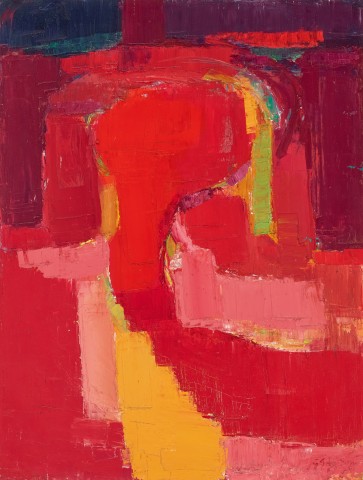IRONSTONE RIDGE, 1978
GUY GREY-SMITH
oil and beeswax emulsion on muslin on composition board
122.0 x 93.0 cm
signed and dated lower right: G Grey Smith / 78
bears inscriptions verso: No 6 / GUY GREY SMITH / ‘IRON STONE RIDGE’
inscribed with title on frame verso: IRONSTONE RIDGE
Gallery 52, Perth
Private collection, Perth, acquired from the above c.1984
Thence by descent
Private collection, Canberra
Guy Grey-Smith, Gallery 52, Perth, 13 September - 3 October 1979, cat. 6
We are grateful to Mark Grey-Smith for his assistance with this catalogue entry.
Shortly after his successful touring Retrospective held at the State galleries in Brisbane and Perth during 1976 – 77, Guy Grey-Smith bought an ‘ancient’ 150 Cessna and rediscovered his love of flying. As a pilot on secondment to the RAF in the early stages of the Second World War, he had previously mused that there was something spiritual about flying. ‘You are alone in the sky’, he said, ‘and you face your problems alone. The solitariness is the thing the pilot has in common to the artist.’1 He now began to progressively re-explore the Western Australian landscape, one he knew intimately at ground-level having camped regularly with his family throughout the state since the late 1950s. Grey-Smith adapted his process of recording as he flew, somewhat recklessly, with a ‘sketch book on my knee and my left hand on the controls ... The plane almost drives itself.’2 Ironstone ridge, 1978, is identified by the artist’s son Mark as being based on an aerial view of salt lakes, probably in the Meekathara region of Western Australia, on Yamatji lands.
During the 1960s, Grey-Smith developed a distinctive, personalised style that fused the ideas of Cézanne and Nicolas de Staël, using trowels and scrapers to apply slabs of bold pigment bulked up by the addition of a homemade beeswax emulsion. Seen up close, it is as if these passages collide with each other, rather than dissolving at the periphery; indeed, the raised edges of the emulsion clearly reveal where each tool started and then left the board, puckering in its wake. Further, the visibility of underlying paint at these junctions ‘reveals the effort involved in (the artist’s) placing colour and form.’3 Grey-Smith’s was a physical process, an expression for him of nature’s life force: ‘I build pictures; they’re structures really.’4
In 1978, Grey-Smith won the prestigious Georges Invitation Art Prize in Melbourne and held a solo show at Ann Lewis’ Gallery A in Sydney. The following year, he was awarded first prize in the McGregor Acquisitive Art Competition in Toowoomba and was invited to enter the John McCaughey Memorial Art Prize at the National Gallery of Victoria. Amidst this, he prepared for what was to be his last solo exhibition, at Perth’s newly opened Gallery 52. As before, the colour literally streamed out of the gallery windows with the installation dominated by two large – and contrasting – views of ‘breakaway’ country around Mt Magnet. In between was a cohesive body of paintings inspired by the regions around Meekathara and Lake Moore, augmented by densely lush expressions of Grey-Smiths beloved karri forests found near his home in the south-west of the state. Running through these was a sense of the artist’s abiding environmentalism, one enraged by the mining and timber industries’ savaging of the landscapes he loved and knew so well. This is less obvious in Ironstone ridge where the artist infuses the otherwise inhospitable salt lakes with patches of citrus green and orange, playing off the deep reds of the iron-rich flatlands. In a deliberately fauvist touch, Grey-Smith also inverts the colour of the lake so that it too is as red as the surrounding country.
1. Hetherington, J., Australian Painters: forty profiles, FW Cheshire, Melbourne, 1963, pp.148 – 49
2. McGrath, S., ‘Trees company’, The Australian, 5 October 1978, np
3. Kubik, M.E., ‘The matter of Guy Grey-Smith’s paintings: methods and materials’, in Harpley, M., Guy Grey-Smith: art as life, exhibition catalogue, Art Gallery of Western Australia, Perth, 2014
4. Guy Grey-Smith, 1978 cited in Western Australian Film Stories on the Arts, ABC program number PWY7521. Date of transmission: 19 October 1979
ANDREW GAYNOR
